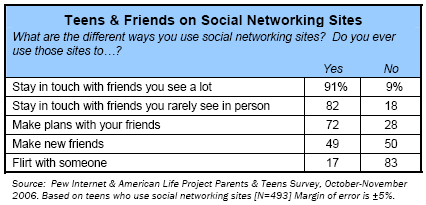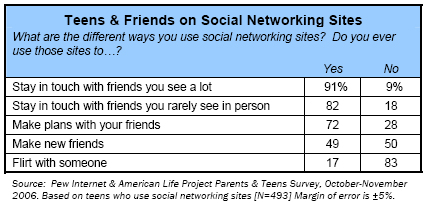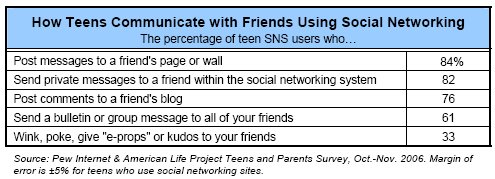55% of online teens use social networks and 55% have created online profiles; older girls predominate
More than half (55%) of all online American youths ages 12-17 use online social networking sites, according to a new national survey of teenagers conducted by the Pew Internet & American Life Project.
The survey also finds that older teens, particularly girls, are more likely to use these sites. For girls, social networking sites are primarily places to reinforce pre-existing friendships; for boys, the networks also provide opportunities for flirting and making new friends.
A social networking site is an online place where a user can create a profile and build a personal network that connects him or her to other users. In the past five years, such sites1 have rocketed from a niche activity into a phenomenon that engages tens of millions of internet users. The explosive growth in the popularity of these sites has generated concerns among some parents, school officials, and government leaders about the potential risks posed to young people when personal information is made available in such a public setting.
The survey, conducted by telephone from October 23 through November 19, 2006 among a national sample of 935 youths ages 12 to 17, asked about the ways that teenagers use these sites and their reasons for doing so.
Among the key findings:
- 55% of online teens have created a personal profile online, and 55% have used social networking sites like MySpace or Facebook.
- 66% of teens who have created a profile say that their profile is not visible to all internet users. They limit access to their profiles.
- 48% of teens visit social networking websites daily or more often; 26% visit once a day, 22% visit several times a day.
- Older girls ages 15-17 are more likely to have used social networking sites and created online profiles; 70% of older girls have used an online social network compared with 54% of older boys, and 70% of older girls have created an online profile, while only 57% of older boys have done so.
Teens say social networking sites help them manage their friendships
- 91% of all social networking teens say they use the sites to stay in touch with friends they see frequently, while 82% use the sites to stay in touch with friends they rarely see in person.
- 72% of all social networking teens use the sites to make plans with friends; 49% use the sites to make new friends.
- Older boys who use social networking sites (ages 15-17) are more likely than girls of the same age to say that they use social networking sites to make new friends (60% vs. 46%).
- Just 17% of all social networking teens say they use the sites to flirt.
- Older boys who use social networking sites are more than twice as likely as older girls to say they use the sites to flirt; 29% report this compared with just 13% of older girls.

The Pew Internet Project survey was conducted from October 23 to November 19, 2006 and has a margin of error in the overall sample of plus or minus 3 percentage points.
More details from the survey
Who has created profiles online
Teens of all types have created profiles, but older girls are the most likely to have posted a profile online.
Among 12 and 13 year olds, 37% report creating an online profile, while 63% of teens ages 14-17 have posted a profile. Breaking the data down further, older girls are the most avid users of social networking sites, and are more likely to have posted a profile online. Seven out of ten (70%) online girls 15-17 have created a profile, compared with 57% of older boys.
The vast majority of online teens (more than 9 out of 10) who said they had used social networking websites also said that they had a profile online. However, about 4% of online respondents said the profiles they use most often are posted somewhere other than on a social networking site.2 Conversely, nearly 5% of online teens who reported use of a social networking site said they had not posted a profile online, which suggests that there is a very small subset of visitors to social networking websites who merely view the profiles of others and do not create profiles of their own.
MySpace dominates the social networking world
Fully 85% of teens who have created an online profile say the profile they use or update most often is on MySpace, while 7% update a profile on Facebook. Another 1% tend to a primary profile on Xanga. Smaller numbers told us they have profiles at places like Yahoo, Piczo, Gaiaonline and Tagged.com.
While the vast majority of profile creators update MySpace profiles most often, there are some differences between boys and girls in the sites they choose to use. Young men are more likely than young women to say they use MySpace most often (90% of boys who have created profiles use the site, compared with 81% of girls). Conversely, teen girls are more likely than boys to say that they use Facebook most often; just 4% of boys who create profiles use Facebook as their primary account compared with 9% of girls. Among older girls who have profiles (ages 15-17), the percent using Facebook as their primary account rises to 12%.
MySpace and Facebook are both social networking sites, but they are very different types of social networking systems. MySpace is open to anyone, and has loose age restrictions; in essence, users can create whatever type of profile and network there that they choose. Until shortly before this survey was conducted, Facebook was arguably a more “closed” system than MySpace.3 High school students could only be added into their high school’s network by a group of other students who verified them as members of that school community. In Facebook, users are encouraged and often required to register using their real name, effectively connecting the user with their offline identity. Even with the new level of openness that Facebook allows, it is still primarily organized around real-world physical communities – first college campuses and later high schools, employers and geographic regions. All of these factors may contribute to the fact that a small contingent of girls, particularly older girls, prefer the Facebook-style system over the more open MySpace environment.
How often teens visit social network sites and post information
In focus groups and other settings, teens have told us that a social network profile is more engaging if it changes frequently. Thus, those who are most interested in maintaining an appealing profile must make frequent visits to social network sites, both to edit one’s profile and to view the profiles of others. Almost half of social network-using teens visit the sites either once a day (26%) or several times a day (22%). Nearly 17% visit the sites 3 to 5 days a week and 15% visit one to two days a week. One in five or 20% say they visit every few weeks or less often.
[Pew Internet Project’s Teen Parent 2006 Study, fielded October-November 2006]
66% of teens who have created profiles limit access to their profile pages
While 55% of online teens have created a profile, not all of these profiles are visible to the entire internet at large. More than three out of four (77%) teens who have created profiles say that their profile is currently visible online, while 21% say their profile is not currently visible. Of those users who have viewable online profiles, more than half (59%) say that their profile is visible only to their friends. Another 40% say that their profile is visible to anyone who happens upon it online. Just 1% of social network users say they do not know who can see their profile.
Teens say social networking sites help them manage their friendships
The vast majority of teens who use social networking sites say they use the sites to maintain their current friendships, while half report using the sites to make new friends. Teens say they use social networking sites to stay in touch with friends they see a lot (91% of social networking teens report this), but also to maintain contact with those friends they rarely see in person (82%). Just half of all social networking teens report using the sites to make new friends.
In addition to socializing online, teens employ social networking sites for scheduling and coordinating events with friends. Three out of four social networking teens (72%) say they use the sites to make plans with their friends. However, few teens report (or admit to) using the networks to directly engage those they are romantically interested in; only a modest number (17%) of social networking teens say they use the sites to flirt.

While teenage girls report higher levels of social networking site use overall, older boys, once they are using the sites, are more likely to take advantage of the true online “networking” features of these communities. Older boys who use social networking sites (ages 15-17) are more likely than girls of the same age to say that they use social networking sites to make new friends (60% vs. 46%).
Older boys who use social networking sites are also more than twice as likely as older girls to say they use the sites to flirt; 29% report this compared with just 13% of older girls.
Older teen girls (ages 15-17), on the other hand, almost universally use the networks both as a way to maintain contact with current friends, and as a bridge to friends they seldom see. Overall, older teens are more likely than younger teens to report using the sites to communicate with those they rarely see in person (86% vs. 76%), but older teen girls are the ones who account for much of this gap. Nine in ten (90%) older girls who use social networking say they rely on the sites to stay in touch with friends they rarely see in person, compared with just three in four (74%) younger girls (ages 12-14). In comparison, 81% of older teen boys, and 78% of younger boys say they use social networks to maintain friendships with people they rarely see.
Social networks provide public and private communication tools
Social networking websites offer a variety of ways to communicate with people both in and out of one’s personal network. There are private messages that can be sent from user to user, but there are also more public means of communicating within the social networking space. A user can post messages to a friend’s page or wall, send a bulletin or group message to a user’s network, post comments to a friend’s blog, or give e-props, “pokes” or kudos by posting small icons to a friend’s page.
The most popular way of communicating via social networking sites is to post a message to a friend’s profile, page or “wall.” More than 4 in 5 social network users (84%) have posted messages to a friend’s profile or page.
Another very popular activity is sending private messages to a friend within a social networking system – a sort of internal email. Fully 82% of social networking site users have sent a private message within the system. Three out of four online social network users have posted a comment to a friend’s blog, and more than six in ten (61%) social network users have sent a bulletin or group message to all of their friends in their online social network. Fewer social networking teens have used the wink, poke, “e-props” or kudos features of various social networks, with just 33% saying they have done that online.
Girls (89%) are somewhat more likely than boys (79%) to post comments to a friend’s profile page or ‘wall.” Much of the difference between boys and girls lies with younger boys, of whom only 74% have posted to a wall within a social networking site.

Methodology
The Parents & Teens 2006 Survey sponsored by the Pew Internet and American Life Project obtained telephone interviews with a nationally representative callback sample of 935 teens age 12 to 17 years-old and their parents living in continental United States telephone households. The telephone sample was pulled from previous PIAL projects fielded in 2004, 2005, and 2006. Households with a child age 18 or younger were called back and screened to find 12 to 17 year-olds. The survey was conducted by Princeton Survey Research Associates International. The interviews were done in English by Princeton Data Source, LLC from October 23 to November 19, 2006. Statistical results are weighted to correct known demographic discrepancies. The margin of sampling error for the complete set of weighted data is ±3.7%. The response rate for the full survey is 46% of the previously interviewed households.
About the Pew Internet & American Life Project
The Pew Internet Project is a non-partisan, non-profit research center that examines the social impact of the internet. It is part of the Pew Research Center and is funded by the Pew Charitable Trusts. Learn more about the Project at our website: https://www.pewresearch.org/internet.
Thanks to Xingpu Yuan for her assistance with this memo.




